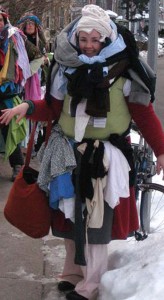1. One of the many environmental stresses would be the
cold. Cold weather negatively impacts the survival of humans by disturbing homeostasis. Naturally, our bodies' temperature is usually around 98.6
°F. Homeostasis can be disturbed if our temperature gets too low, which can cause us to get hypothermia. There can be either mild or severe cases of hypothermia. In mild cases, the blood vessels become more narrow (vasoconstriction) which can cause an increase in blood pressure and also an increase in heart rate. In more moderate to severe hypothermia, one might feel confused, have difficulty with our motor skills as our muscles have to work much harder in order to control movements during this time. A person can also experience the Hunting reaction, which is the alternation of vasoconstriction (narrowing blood vessels) and vasodilation (blood vessels widen) in the exposure of high extreme cold temperatures. In these more severe cases, heart rate and blood pressure begins to decrease. Some other symptoms include memory loss, decrease in breathing, shut off of the heart and liver is also seen as the shut off of certain organs serves as protection for keeping the brain alive. External changes in our body is also seen, such as getting frostbite. Extremely sever cases of low body temperature can even result in death.
2. Humans have adapted to this stress by:

- Short Term: Shivering can help bring the body back to homeostasis. By shivering, we are moving our body and muscles which help conserve heat and energy.

- Facultative: Vasoconstriction and vasodilation can be an examples of this as vasoconstriction attempts to reduce the loss of heat in the body. The narrowing of the blood vessels helps regulate warm blood flowing near the skin and that prevents heat from being lost. On the other hand,Vasodilation widens the blood vessels which then increase the blood flow and reduce the amount of energy lost, while also conserving body heat.

- Developmental: A layer of fat that works as insulation for a person's body in order to maintain heat. Those who live in colder areas tend to be shorter and heavier or rounder in shape in comparison to those that don't live in cold areas. Their low surface area to mass ratio helps contain body heat so that it is not lost.

- Cultural: Clothing layers/heavy clothing, in-door heaters, warm food/drinks can all be cultural adaptations. People in colder areas might wear a vast amount of layers or heavy clothing in order to keep warm. Those who stay in-door or even those who commute can keep themselves warm by turning on the heater. Eating warm soup or teas is also commonly used in various cultures to keep the body warm.
3. The benefits of studying human variation from this perspective is that we get inform ourselves on the effects of specific stresses have on our body. This increases our knowledge in the sense that we learn about what happens internally and externally, and how the effects can be beneficial in helping our bodies maintain homeostasis. Overall, it can also help us learn a bit about our ancestors and how the changes in their bodies cause by environmental influences helped keep them warm during cold times. This information can be used in a productive way, for example, in this case, instead of trying to stop the shivers, I can now understand that it is a natural process and my bodies own way of trying to keep itself warm.
4. I believe that race can not be used in understanding the variation of the adaptations. The study of environmental influences on adaptations is a much better way to understand human variation because we can compare the living conditions to the way our body reacts. We all have the same organs, the same bodily functions, and most likely our bodies will react similar to others' in similar environments. Not one race's body will act different, or one race's body will have different responses to something. It will most likely be do to the environment influences.




You have some good points in your opening section, but you are also confusing adaptations with the problems the body faces in cold environments. Vasoconstriction and the "hunting reaction" are both adaptations. They are how the body adapts to the cold. They are not technically a problem... they are the body trying to deal with the problem.
ReplyDeleteYou discuss the issue of hypothermia, which IS one of the problems the body faces in cold stress, but let's get to the core problem here... Why can't the body function well if it's core temperature drops below 98.6 degrees? What happens to the organs and the circulatory system?
Well done discussing the short term and facultative responses.
Regarding the developmental adaptation, it is partially fat layers, but that can be facultative. The actual developmental (i.e., acquired at birth) is the body *shape*. You do refer to this, but get stuck on the idea of fat layers, when it is the shape of the body itself (core and limbs) that is the developmental adaptations. Shorter, squatter body shapes have less surface area per body mass than long thing bodies, giving less opportunity for heat loss through the skin. This relationship is described by Bergmann and Allen's rules, explained in the resources in the assignment module.
Good cultural discussion, but your image isn't available.
I agree that knowledge is always useful, but can you identify a way this knowledge can be useful in a concrete way? Can knowledge on adaptations to cold climates have medical implications? Help us develop clothing that retains heat more efficiently? Can we develop new means of home/building construction that might help increase heat retention? How can we actually use this information in an applied fashion?
I agree with your conclusions in the last paragraph but what to clarify your reasoning. To answer this question, you first need to explore what race actually is. Race is not based in biology but is a social construct, based in beliefs and preconceptions, and used only to categorize humans into groups based upon external physical features, much like organizing a box of crayons by color. Race does not *cause* adaptations like environmental stress do, and without that causal relationship, you can't use race to explain adaptations. Race has no explanatory value over human variation.
Professor Rodriguez,
DeleteThanks for the response on my post. Not sure why you aren't able to see my image of the cultural discussion. It shows up on mine, and I used firefox as you suggested for editing the post. For cultural, it is an image of a woman wearing a ridiculous amount of layers of clothing to keep warm :)
I actually reopened it and the image works correctly. I was using a really slow internet source and I think my computer just gave up. ;-) No worries.
DeleteHello!
ReplyDeleteVery well written post followed by informative and fun images. It was very interesting to compared to different blogs and notice how each was talking about the same thing and I felt your blog was so detailed that it set a high standard for other blogs. On top of that, your blog gave me awesome information about the adaptive changes and variations that the body goes through when temperature in the environment drops. Overall Great job!
Hiya,
ReplyDeleteI thought you did a pretty good job on this! I liked the funny pictures you put and I liked how it was very detailed. It was interesting reading your post and theres nothing I would tell to change about it. Great job!